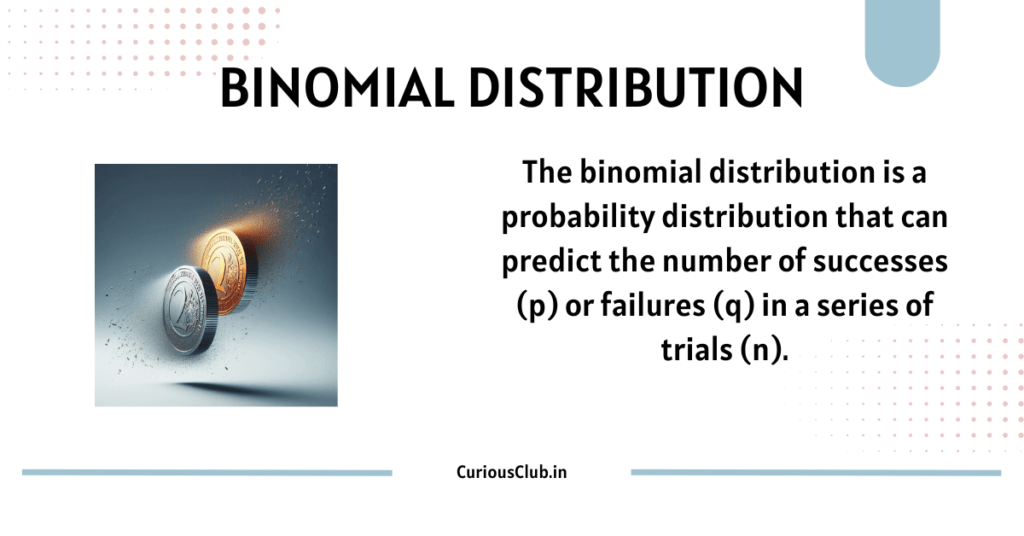
What is Binomial Distribution?
The binomial distribution is a probability distribution that is used in situations where there are two possible outcomes in a series of events or in a series of independent trials, it describes the likelihood of getting a certain result in those trials.
to understand better, imagine flipping a coin 100 times, binomial distribution can predict the number of heads or tails out of 100 flips.

Assumption of Binomial distribution
- The experiment involves n identical trials.
- Each trial has only two possible outcomes denoted as success or failure.
- Each trial is independent of the previous trials.
- The term P and q remain constant throughout the experiment, where p is the probability of getting a success on any one trial and q (1-p) is the probability of getting a failure on any on trial.
Key Characteristics of Binomial distribution
Two Possible Outcomes: In binomial distribution there could be only 2 possible outcomes, they are often called as “Success” or “Failure”, or they are also represented as 1 or 0, which translates to success or failure. For example, in the coin flip example, success is getting heads and failure is getting tails.
Independent Trials: Each trial is independent, meaning that the outcome of one trial does not impact the outcome of the other. For example, in flipping a coin result of first trial does not have any influence on the outcome of subsequent trials.
Fixed Probability: The probability of a success (p) or failure (q) remains constant throughout the entire series of trials.
Fixed Number of Trials: The number of trials (n) is fixed and predetermined before the experiment begins, meaning you are aware of how many trials are going to occur.
Mean (μ) of Binomial distribution
The mean here represents the average number of successes in n number of trials. It informs about how many successes you can expect given the probability of success (p) and number of trials (n).
Mean (μ): μ = n * p
- n = number of trials
- p = probability of success in each trial
Standard Deviation (σ) of Binomial distribution
A standard deviation (σ) here indicates the spread of possible outcomes around the mean (μ), a bigger number in standard deviation suggests more variability in the number of successes that might be observed compared to average.
Standard Deviation (σ): σ = √(n * p * (1 - p)) or σ = √n*p*q
- n = number of trials
- p = probability of success in each trial
Binomial Distribution is used for categorical data
When we talk about categorical data it has a vast meaning and number of types of data, for example, eye color (blue/brown/green) or types of fruit (apple/orange/banana), in the context of binomial distribution correct term would be binary categorical data where are only two options like gender (male/female) or answer in survey options are Yes or No. It is aligned with core requirement of calculating binomial distribution where there are only two possible outcomes.
Applications of Binomial Distribution
Because binomial distribution deals with situations where there are only two possible outcomes, it has a range of applications. Here are some examples of fields where binomial distribution is used.
| Field | Use case |
| Quality Control | Predicting defective items in a batch. |
| Medical Research | Analyzing positive responses in drug trials |
| Business | Estimating customer conversions. |
| Polls | Understanding public opinion from yes/no answers. |
| Biology | Analyzing genetic test results. |
| Insurance | Calculating premiums based on risk. |
| Games | Estimating winning probabilities (think simple games). |
Calculation of Binomial Distribution
The function used to calculate the binomial distribution might seem complicated but once you have understood it will be eazy.
p(x) = (nCx) * p^x * q^(n-x)
Where:
- p(x) – Probability of getting x successes.
- n – Total number of trials.
- x – Number of successes you’re interested in calculating the probability for.
- p – Probability of success in a single trial (between 0 and 1).
- q – Probability of failure in a single trial (q = 1 – p).
- (nCx) – Binomial coefficient, which can be calculated using various methods (combination calculators online or libraries in programming languages).
Cumulative v/s Density in Binomial Distribution
Binomial distribution can be used for two main purposes:
- Calculating the probability of getting a specific number of successes which is the density function.
- Understanding the probability of getting a certain number of successes or less which is cumulative distribution function.
Function for calculating binomial distribution
We have already seen the function to calculate the binomial distribution which is density function there are mainly 2 approaches to calculate the cumulative distribution function,
Recursion: In this method the probability of each possible outcome using density function is calculated and they are all summed up for all outcomes from 0 to x successes.
Special mathematical function: This method involves use of more efficient functions then recursive, there are multiple online calculators available for this, binocdf (x, n, p) and pbinom (x, n, p) are common names for these functions. These functions take the following arguments:
- x – Number of successes you’re interested in (cumulative probability up to x successes).
- n – Total number of trials.
- p – Probability of success in a single trial.
Example
Let us take an example to understand how to calculate binomial distribution,
A bank issues Gold Credit Cards, from the past data it is determined that 70% of all accounts pay on time. If a sample of 7 accounts in selected at random, Construct the binomial distribution of account paying on time.
What is Poisson Distribution?
Poisson distribution calculates the probability of getting a specific number of events within that interval, assuming a constant rate of events and independent occurrences. It focuses on the number of events happening in a fixed interval (time or space). For example, the probability of a certain number of customer arrivals in a store per hour.
Difference between Poisson Distribution and Binomial Distribution
| Feature | Poisson Distribution | Binomial Distribution |
|---|---|---|
| What it Describes | Number of events in a fixed interval (time or space) | Number of successes in a fixed number of trials |
| Key Assumptions | * Constant rate of events * Independent events | * Fixed number of trials * Independent trials * Constant probability of success (p) for each trial |
| Formula | P(x) = (e^(-λ) * λ^x) / x! | P(x) = (nCx) * p^x * q^(n-x) |
| Parameters | * λ (average rate of events in the interval) | * n (total number of trials) * p (probability of success in a single trial) * q (probability of failure = 1 – p) |
| Applications | * Customer arrivals * Car accidents * Insurance claims * Radioactive decay | * Coin flips * Medical test results (positive/negative) * Customer satisfaction surveys (yes/no) |
| Mean & Variance | Mean (μ) = Variance (σ^2) = λ | Mean (μ) = n * p |
| Example | Probability of a certain number of customer arrivals in a store per hour | Probability of getting a specific number of heads in 10 coin flips |
| Notes | * Can be used as an approximation for the binomial distribution when n (trials) is very large and p (success probability) is very small, such that np ≈ λpen_spark |
We hope you found the information helpful! If you learned something valuable, consider sharing it with your friends, family, and social networks.
Inspired by: Khan Academy
Also Read:
- Understanding Standard Deviation: A Measure of Spread
- Sample Variance Demystified: Mastering Your Analysis with Essential Insights 101
- Nabard Financial Services NABFINS Recruitment 2024
Hi, I am Vishal Jaiswal, I have about a decade of experience of working in MNCs like Genpact, Savista, Ingenious. Currently i am working in EXL as a senior quality analyst. Using my writing skills i want to share the experience i have gained and help as many as i can.
